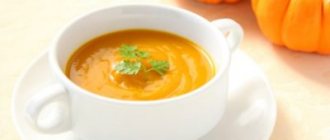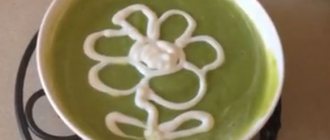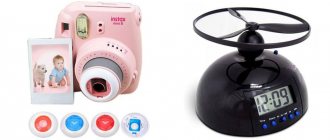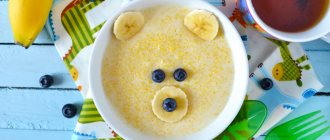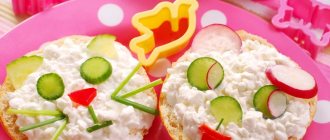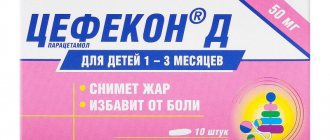Benefits of the product for baby nutrition
Fish is used in cooking as an alternative to meat, although it is not as nutritious in terms of fat content. But the product contains large quantities of protein and other elements important for the development of the body.
Nutritional value
Fish supplies children with complete protein. It has higher lipotropic properties than the meat of warm-blooded animals due to its high methionine content. This amino acid is involved in many vital processes occurring at the cellular level:
- synthesis of other protein components;
- DNA modifications;
- maintaining cell functioning;
- tissue regeneration, etc.
Fish oil, consisting of unsaturated acids, is also biologically valuable. This is the main natural source of arachidonic acid, necessary for the rapid restoration of muscle tissue. This product is especially important for children who are bottle-fed - it supplies the body with the Omega-3 group.
Additional Information. Fish contains a lot of fat-soluble vitamins: D, retinol, group B (riboflavin, thiamine, cyanocobalamin), nicotinic acid. This is a good remedy for the prevention of rickets and anemia.
The product is a source of mineral salts. The composition is dominated by calcium and phosphorus. There is less iron in fish than in meat. But representatives of the sea will give the body 30 times more iodine than animal fillet.
Useful product
Fish, compared to meat, is easier to digest and more fully absorbed, due to the smaller amount of connective tissue (5 times). The feeling of fullness after consuming the product is lower.
How to choose the right fish
The calorie content of a dish introduced into a baby's menu is proportional to its fat content. The richer the product, the more difficult it is to digest and the more difficult it is to be absorbed by the child’s body. Therefore, the mother should know which fish to start complementary feeding with.
Varieties
At what age can you give your child tangerines?
All fish are divided into 3 grades according to the percentage of fat they contain:
- lean (up to 4%);
- medium fat content (over 4 to 8%);
- fatty (more than 8%).
Fish for the first feeding, as Komarovsky advises, should be lean, but not dry. These varieties include pollock, haddock, river perch, pike perch, cod, and pike. When the baby gets used to the new product, he can be introduced to the menu with moderately fatty species (carp, herring, bream, trout).
Important! It is better not to give red fish to a child under one year old. The list of this variety includes beluga, salmon, sturgeon, salmon. They are too heavy for an infant's digestive system and can cause stomach upset.
Fish quality
It is important not only to know what kind of fish to start feeding your child with, but also how to choose it. The fresher the product, the more benefits it will provide. The quality of fish is determined by the following criteria:
- smooth shiny scales lying close to the body;
- bright red gills;
- bulging transparent eyes;
- unbloated abdomen.
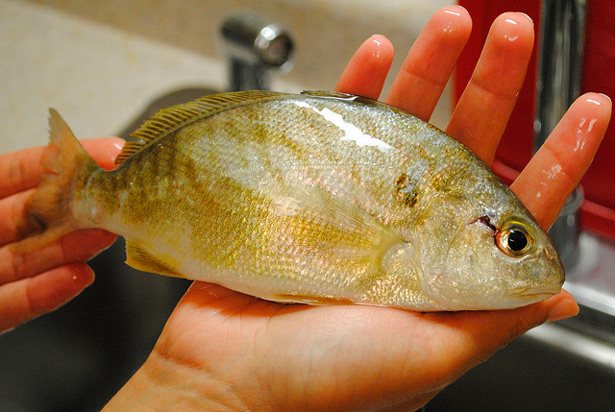
Be sure to pay attention to quality
You can take frozen fish if it was frozen by natural cold while alive. Then, with proper defrosting, it will not differ in quality from fresh.
How to choose and cook correctly
There are a number of rules that are recommended to be followed when purchasing and preparing:
- Winter and spring catches are of great benefit.
- The freshness of the fish can be judged by the presence of bright red gills, light eyes without cloudiness and films.
- Proper freezing is indicated by the ringing sound that appears when struck.
- The freshly frozen product has light pink meat. A dark color indicates re-freezing.
- For kids, it is better to buy fresh fish.
- It is better to boil the product whole or in large pieces. This method allows you to maintain juiciness.
- Steamed dishes provide maximum benefit. They retain more valuable substances.
- When boiling, you need to lower the fish into the water after it has boiled - this way the product will not overcook and will retain its taste.
- Red fish for children is prepared without seasoning.
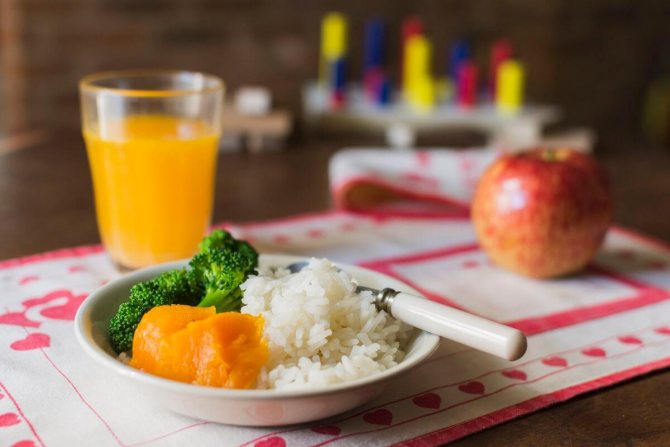
When is fish introduced into the diet?
At what age can you give your child a fresh apple?
Fish is a mandatory supplement for the harmonious development of a baby, but you should not introduce it to the menu ahead of time. It is more rational to use the product during the period when the daily diet includes 3 dense feedings, and the digestive system has already become accustomed to animal protein. For most children it occurs in the 9th month. Toddlers on IV are given fish complementary food a little earlier - 20-30 days.
This dish is included in the lunch diet, but the child is not fed fish every day - 1-3 times a week, replacing it with a meat product.
Canned fish
You cannot feed your baby canned food intended for adults; a special fish and vegetable product is produced for babies. This is an almost ready-to-eat dish. It is enough to heat the fish with a side dish and give it to your child for lunch.
Canned food with the addition of vegetables and cereals is produced in varying degrees of grinding, taking into account the age characteristics of the child’s body:
- puree - recommended for babies 8-9 months old;
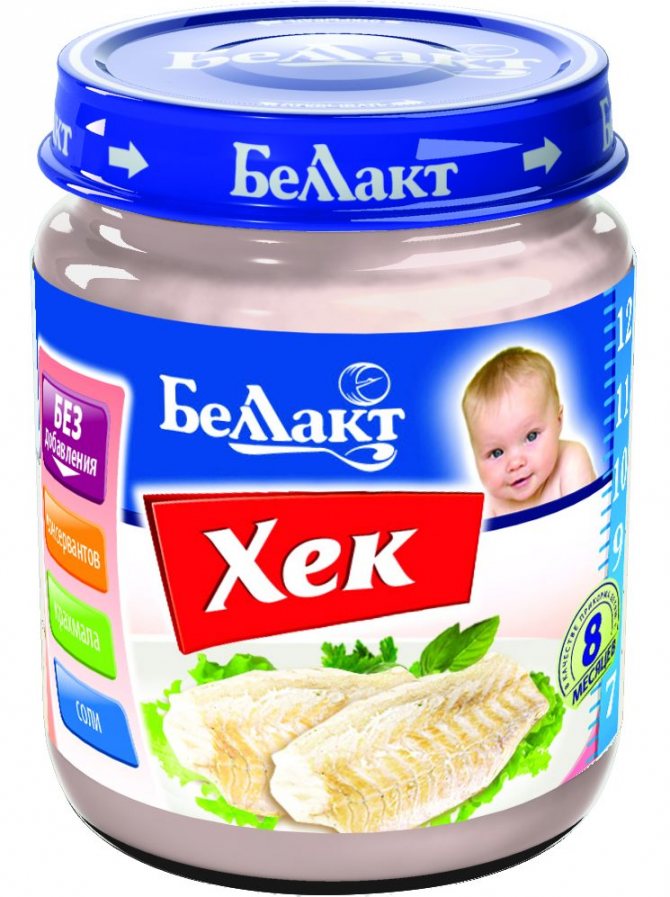
Fish puree for baby
- coarsely ground - introduced into complementary foods at 11-12 months;
- Canned food in pieces is designed for a one-year-old child.
Having decided when to introduce fish into your baby’s complementary foods, when purchasing, you should carefully study the labels on canned food, which are produced in glass or tin jars weighing 100-200 g.
When can you give pollock?
Pollock is a low-fat and low-calorie dietary fish that is suitable for the first fish feeding for infants. But, despite the benefits and benefits of this product, pediatricians advise not to rush into administration. After all, any fish, even white low-fat varieties, are a strong allergen. Therefore, it is important to know at what age it is safe to introduce fish into a child’s diet.
White varieties of fish can be given after the introduction of the main types of meat, cereals, vegetables and fruits, and dairy products. If the child does not have an allergy or a tendency to this disease, pollock can be introduced up to a year at the age of 9-10 months. If you are prone to allergies, fish should only be included at 1 year of age.
For the first time, we prepare fish puree for the baby, prepared in water without salt and sugar. For taste, add a little vegetable oil, breast milk or formula. Give your baby half or a quarter of a teaspoon of puree and monitor your baby’s well-being.
If the child reacts normally, you can gradually increase the dosage and prepare dishes from pollock. The daily intake of fish should not exceed 50 grams for ten months, and 60 grams for one year. Do not forget to allow intervals of three to five days when introducing different fish varieties.
It is not recommended to serve fish dishes more than twice a week, since fish allergies are often cumulative. Fish protein gradually accumulates in the body and increases the risk of developing an allergic reaction. Therefore, it is not a fact that an allergy to pollock will appear in the first hours or even days after trying complementary foods.
Pollock should not be given to children prone to allergies to marine fish and seafood. By the way, if a child is allergic to river fish, it is not at all necessary that he will be allergic to sea fish and, vice versa.

How to cook fish properly
At what age can you give your child cheese?
It is not recommended to give fried foods to babies under one year old. This also applies to fish, so use boiled or steamed fillets. Then it is pureed with an immersion blender (or passed through a meat grinder).
In the future, the diet will be diversified by preparing boiled meatballs, steamed cutlets, meatballs, and soufflé. Such a gradual transition will prepare the toddler’s digestive system for eating cut-up fish.
How to boil fish
You can prepare the product in one whole piece or cut the fillet into slices of 75-100 g. In the first option, the fish will turn out more juicy and tasty. First, the pulp is carefully separated from the bone and only then start cooking:
- fillet fillet with hot water;
Note! Take a little liquid - it should only cover the fish. This will make the dish tastier.
- put on fire;
- as soon as the broth boils, remove the foam;
- Reducing the flame to low, cook for 15-20 minutes.
The finished fish is cooled and crushed to a puree. If instead of cooking water you use a vegetable broth based on carrots, celery, parsley, this will increase the nutritional value of the dish.
Fish cutlets
For a 10-month-old baby, you can already prepare food from raw minced meat. At the same time, you should not throw away the bones from the fish - they are used to cook the broth, which will be needed in the subsequent algorithm:
- raw fish fillet (0.5 kg) is passed through a meat grinder;
- the pulp of white bread or loaf (100 g) is poured with warm milk (100 ml);
- mix the ingredients and form small cutlets;
- Place a colander on the pan with the broth, greasing it with butter;
- lay the cutlets evenly;
- cover with a lid and steam until done.
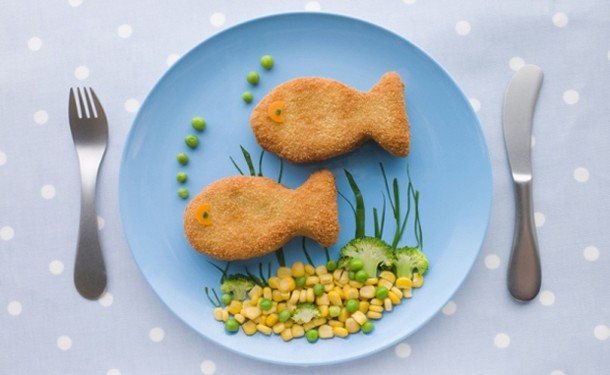
Fish cutlets
The minced meat can be formed into meatballs. They are not placed in a colander, but at the bottom of the pan and filled with broth so that the liquid covers the fish “balls” by ¾. Cook the meatballs over low heat for 15-20 minutes.
Steamed soufflé
You can prepare an original dish from fish that will please any baby. First you need to take 150 g of pike perch, remove bones and skin, then divide it into 2 parts. The next steps are:
- boil one part of the fillet;
- cool and pass through a fine-mesh meat grinder 2 times along with raw fish;
- a jelly-like sauce is prepared from milk (40 ml) and flour (1 tbsp);
- mix it with minced meat;
- add the yolk of a raw egg and a little melted butter;
- The mass is mixed well and the beaten egg whites are added to it.
The workpiece is filled into an oiled mold and sent to a steam bath. When serving, pour melted butter over the soufflé.
How to defrost fish correctly
In order for fish dishes to turn out juicy, the frozen product must thaw properly. This can be done quickly by immersing the fish completely in cold water. After some time, all that remains is to rinse it with clean liquid.
Important! Do not use warm water (especially hot water) or defrost the product in the microwave. As a result, the fillet dries out, becomes flabby, tasteless and loses its nutritional qualities.
Pollock recipes for children
Fish soufflé
- Pollock – 100 grams;
- Milk – 50 grams;
- Flour – 20 grams;
- Egg – ½ piece;
- Butter 10 grams.
Cook pollock separately and grind in a meat grinder. Add flour to milk, bring to a boil and simmer for two minutes to form a thick sauce. Add the yolk and melted butter to the minced fish. Beat the egg whites separately and add to the mixture along with the milk sauce. Mix the ingredients, put the mixture in a container and bake in the oven for about twenty minutes at medium temperature.
Fish pate
- Pollock liver – 200 grams;
- White beans – 200 grams;
- Lemon juice – 1 table. spoon;
- Olive oil – 1 table. spoon.
Soak a glass of beans in cool water and leave for four hours. Then cook until tender in a large volume of water. Grind the finished beans to a puree consistency. Mash the pollock liver with a fork and mix with beans, pour in lemon juice and olive oil, salt and pepper to taste. If desired, you can add a tablespoon of chopped herbs. Mix the mass thoroughly. This pate is perfect for making sandwiches for a child for a snack or breakfast.
Potato casserole
- Potatoes – 0.5 kg;
- Pollock fillet – 0.5 kg;
- Cherry tomatoes – 8 pieces;
- Onions – 2 pieces;
- Eggs – 2 pieces;
- Cream 10% – 150 ml;
- Vegetable oil - 1 table. spoons;
- Hard cheese – 100 grams;
- Fresh greens to taste.
Boil the potatoes separately in their skins, peel and let cool. Then grate coarsely, salt and pepper. Wash the cherry tomatoes and cut them into halves, and the fillets into pieces. Place potatoes in a baking container, place chopped onions on top, then fish.
Place the cherry halves on top, skin side up, and sprinkle with grated cheese. Separately, beat the eggs with cream and pour into a dish. Bake for about forty minutes at 180 degrees. Sprinkle the finished casserole with chopped herbs. It turns out beautiful, appetizing and tasty. The prepared casserole goes well with fresh vegetables or vegetable salad.
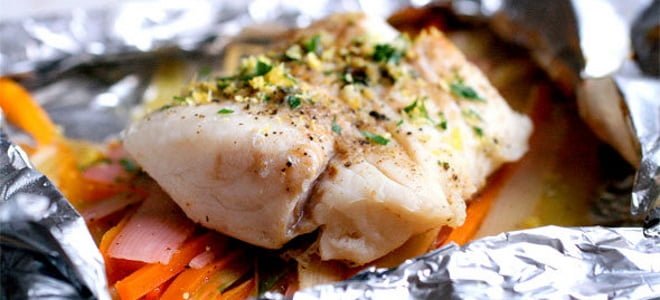
Baked pollock with vegetables in sour cream
- Pollock fillet – 200 grams;
- Potatoes – 8 pieces;
- Green beans – 100 grams;
- Hard cheese – 100 grams;
- Sour cream – 0.5 cups.
- Butter – 50 grams.
Boil the potatoes separately in their skins, peel and cut into cubes. Soak green beans in cold water for ten minutes. Then add fresh water and bring to a boil. The finished pods can be cut if desired. Wash the fillet and cut into small pieces.
Place the potatoes in a baking container and brush with butter. Place fish pieces on top, then beans. Salt and pepper to taste, pour in sour cream and sprinkle with grated cheese. Bake for 20-30 minutes at medium temperature.
Soup with fish meatballs
- Pollock – 100 grams;
- White bread – 30 grams;
- Egg – ½ piece;
- Potatoes – 100 grams;
- Carrots – 50 grams;
- Onions – 50 grams.
Boil the fish separately until cooked, grind through a meat grinder. Soak the bread in milk, mix with minced fish and mince again. Add the egg and salt to taste, mix. From the resulting mass we make small fish cutlets, meatballs or meatballs. They should be tight and not fall apart.
We clean and cut the vegetables, add potatoes to boiling water. Twenty minutes before readiness, add onions, carrots, and meatballs. Sprinkle the finished pollock fish soup with chopped fresh herbs.
Stewed fish with vegetables
- Pollock – 0.5 kg;
- Turnip – 1 piece;
- Carrots – 1 piece;
- Onion – 1 piece;
- Chicken or vegetable broth - 2.5 cups.
Peel clean vegetables, chop onions, grate carrots and lightly fry together in olive oil. Cut the turnips into large cubes, add to the vegetables and fry for another four minutes. Cut the prepared pollock and put it with the vegetables, pour in the broth and simmer under the lid until cooked.
Baked fish with pumpkin
- Pumpkin pulp – 0.5 kg;
- Pollock fillet – 0.3 kg;
- Kefir – 2.5% – 0.5 l;
- Eggs – 3 pcs.;
- Dill or parsley to taste.
Cut the pumpkin, place half in a baking dish and lightly salt. Cut the fillet and place on top, then lay out the remaining pumpkin and sprinkle with chopped herbs. Separately mix kefir with eggs, salt and pepper to taste. Pour the mixture into the dish and bake for forty minutes at a temperature of two hundred degrees.
Fish cutlets
- Pollock – 0.5 kg;
- Egg – 1 pc.;
- Loaf – 170 grams;
- Milk – 70 grams;
- Onion – 30 grams;
- Homemade breadcrumbs – 120 grams.
Soak the bread in milk. Peel and cut the onion, divide the fish into pieces. Combine pollock, onion, soaked bread and egg. Mix the mixture, add salt and pepper to taste. Grind everything in a blender until smooth. From the resulting minced meat we form fish cutlets and roll in breadcrumbs.
Next, bake the pieces in the oven at 180 degrees for about twenty minutes. Serve ready-made pollock cutlets for children with boiled potatoes, rice, pasta or vegetable puree. For even more fish cutlet recipes for children, follow the link /.
Subscribe to our VKontakte group
Fish feeding standards for infants
The product is introduced into the baby’s menu, like any other complementary food, starting with half a teaspoon. The norm is gradually increased, bringing the fish puree to the optimal amount - 50 g (for a 9-month-old child). With the transition to steam cutlets, meatballs, souffle, boiled fillet, the amount of food per day should be 60 g, increasing by year to 90 g.
How often to give
Fish can cause an inappropriate reaction in the baby. Therefore, for the first half a month, the product is given once a week, choosing a specific fish day. Then you can increase the frequency up to 2-3 times. For better digestibility, this complementary food is given to the child at lunchtime, which occurs at 14:00.
What can be combined with
Fish dishes go well with vegetables, cereals and other types of side dishes. A variant of this combination is given in the table:
Lunch menu at 10-11 months
| Meal time | Diet composition | How much to give |
| 14-00 hours | Vegetarian vegetable soup | 3 tbsp. |
| Vegetable puree, seasoned with 1 tsp. vegetable oil | 150 g. | |
| Steamed fish cutlet | 60 | |
| White bread or cracker | 1 PC. | |
| Fruit puree or grated apple | 60 |
Closer to the year, when the child is weaned from the breast, or an adapted formula is removed from the diet, the time of lunch feeding shifts to 12 o'clock due to the fact that the baby has a full breakfast at 8, and not at 10 o'clock in the morning, as before.
When and how to give salmon to your baby
Experts recommend starting to give fatty fish, which includes salmon, to a child after 3 years of age. The first portion should be no more than a teaspoon of meat in the first half of the day. At this time, other new foods should not be introduced into the diet.
The reaction of the child’s body should be observed for 2-3 days. In the absence of allergic manifestations, the portion can be gradually increased to 50 g per day; fish can be given 1-2 times a week.
- From 4 to 7 years, the daily portion can be increased to 70 g;
- from 7 to 14 years old it can be 100 g;
- for teenagers from 14 years old – 200 g.
Possible nutrition problems
Before introducing this product into the diet, you should consult with your pediatrician about when you can give your child fish. After all, according to WHO, it is on the list of prohibited foods for children with allergies.
Even if the mother is sure that the baby does not have a predisposition to such a disease, fish complementary foods should be introduced with caution, observing the body’s reaction. At this point, the little one should be absolutely healthy.
Fatty fish will cause intestinal upset in a child. Fish broth will lead to the same result if given to a toddler. Therefore, a rich liquid, saturated with extractive substances, is used in a baby’s diet only as a basis for a water bath in which steamed dishes are prepared.
Note! Eating freshwater fish can cause food poisoning. Residents of water bodies accumulate salts of heavy metals in their bodies, polluting lakes and rivers.
Signs of allergies
When introduced to a fish product, a child may begin to experience an allergic reaction within a few hours:
- skin rash;
- stool disorder;
- regurgitation and even vomiting.
An allergy can only occur to river or, conversely, sea fish or to one of the varieties. Some children suffer a negative reaction to a home-cooked dish and tolerate canned food just fine.
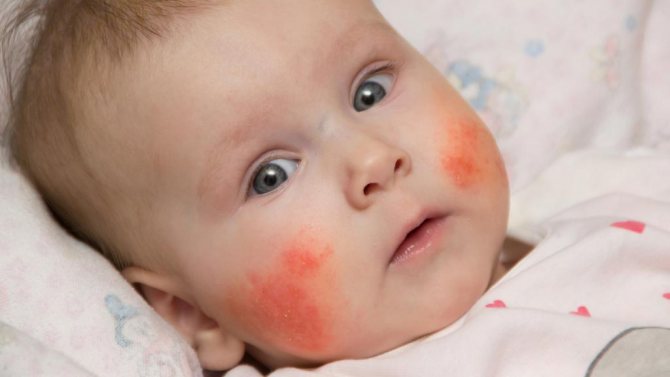
Food allergies
The appearance of an allergy is a signal to hold off on fish supplements. After 2-3 weeks, when the child’s condition has stabilized, the attempt can be repeated, choosing a different type of fish. If the situation resumes, you should consult an allergist.
When to worry
Sometimes an immediate allergic reaction occurs. Its signs are observed immediately as soon as the baby tries fish. In this case, the symptoms are more serious, and the mildest symptom is hives. Severe manifestations include:
- redness and swelling of the lips;
- pale or bluish skin;
- hoarseness in voice;
- restless behavior of the baby.
These are signs of Quincke's edema, which affects not only the tissues of the face - the mucous membrane of the larynx is affected by 20%, which complicates breathing.
If you notice such symptoms, you should immediately call an ambulance. Before the doctors arrive, the child is given an antihistamine - Fenistil or Zyrtec in the age-specific dosage specified in the instructions.
A child predisposed to allergies may even have a reaction to the smell of fish. This is due to the fact that volatile compounds are saturated with protein molecules.
Fish is an important component of a balanced diet for a growing body. The product should be introduced into the baby’s diet with caution due to its allergenic properties.
